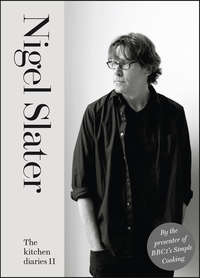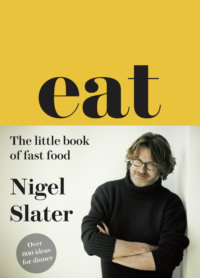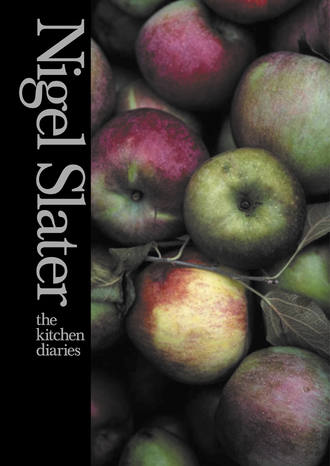
Полная версия
The Kitchen Diaries
Remove the pan from the oven, take off the lid and gently split the bird's legs away from its body, nicking the skin with a knife as you go. Return the bird, legs akimbo and without the lid, to the oven for five minutes.
Remove the legs, then remove each breast in one piece. Put a leg and a breast on each of two warm plates, then divide up the potatoes, celery and their juices.
Enough for 2
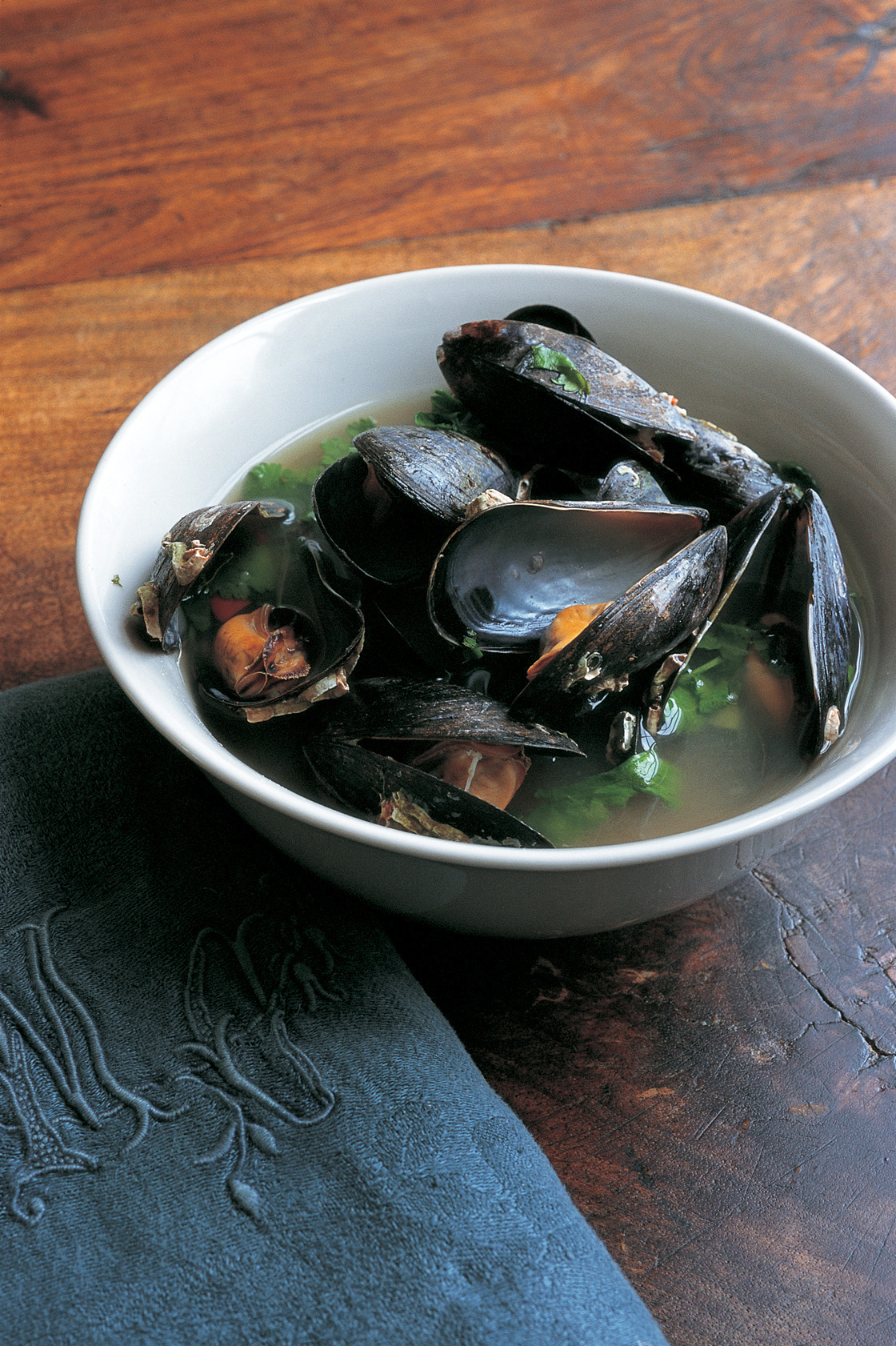
January 29
A hot salad
from the
leftovers
and a clear,
aromatic
soup
There are a few slices of pheasant left, scraps actually. They will do two for supper with some hot onion chutney I found in the cupboard and a plate of boiled potatoes, sliced and fried in hot olive oil. At the last minute I decide to toss the cold cuts with the hot fried potatoes, a couple of spoonfuls of the chutney and a bunch of watercress. It looks a bit of a jumble on the plate, but eats well enough.
A clear, hot mussel soup
The point is that this is a clean-tasting broth, hot and aromatic. If you wish to add fish sauce or even soy sauce, then do, but I suspect the recipe will lose its pure, simple flavours. The coriander is essential.
mussels in their shells – 1kg
light chicken or vegetable stock – 800ml
a small, hot, red chilli
the juice of 2 limes
a little sea salt and sugar
a handful of coriander leaves
Scrub the mussels thoroughly, tug out any of the fibrous ‘beards’ that may be hanging from their shells and discard any that are broken or open. I always squeeze each mussel hard, pushing the shells together tightly to check they have some life in them. Any that refuse to close when squeezed or tapped on the side of the sink, or any that seem light for their size, should be discarded.
Tip the mussels into a large, heavy pot over a high flame and add a splash of water. Cover them tightly with a lid and let them steam for a minute or two, till their shells are just open and the mussels are quivering and juicy. Remove them from the heat the second they are ready.
Bring the stock to the boil. Cut the chilli in half, remove its seeds and chop the flesh very finely, then put it in with the stock, together with the lime juice, a pinch of salt and the same of sugar. Turn the stock down to a simmer.
Remove the mussels from their cooking liquor, pull the flesh from the shells and drop it into the pan of stock, with a little of the mussel juices. Roughly chop the coriander leaves and stir them into the hot soup.
Enough for 2
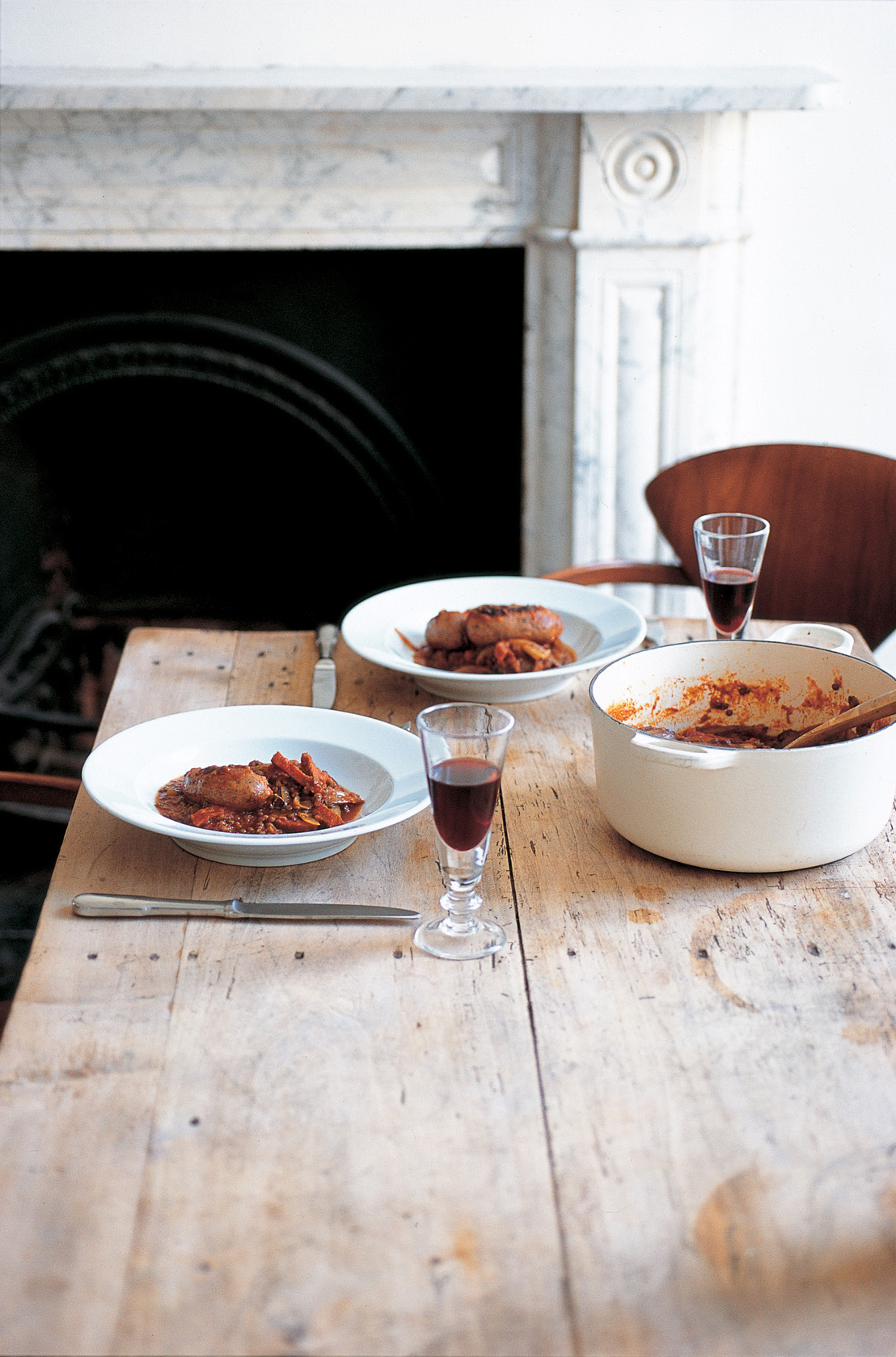
January 30
A sausage
hotpot and
a citrus tart
The air is again clear and cold, and there are paper-white narcissi in a bowl on the table, filling the kitchen with their gentle, vanilla smell. Winter at its purest. This is the sort of day on which I like to bake – a cake, a pie, a tart perhaps. I enjoy making pastry, though rarely do, each time adding as much butter as I dare, just to see how crisp and fragile I can get the crust. Today I want something fresh, with a clean bite to it, a dessert to make everyone smack their lips. I decide on a lime custard tart in the style of a tarte au citron. The lime zest cuts through the cool air. The warm smell of baking pastry wafts into the rest of the house. Heaven. Half way through baking, I check the tart’s progress, only to find the pastry case empty and the citrus filling forming a lemon-coloured pool on the baking sheet. I pile the whole damn failure into a basin (and later eat it in secret after everyone has gone home) and start again. This time I make absolutely certain the pastry case has not the faintest hole or crack in it before I pour in the filling.

Sausages with salami and lentils
A rough-edged casserole that gives the impression of having been cooked for hours but is pretty much ready to eat in forty-five minutes. You could put it in the oven if you prefer, in which case you should let it cook for about an hour at moderate heat. This is the sort of food I like to put on the table at Saturday lunch, with a bowl of rocket salad by the side. Then you can swoosh the salad leaves around your plate to mop up the last bits of tomatoey lentil sauce.
onions – 2 medium
olive oil – 2 tablespoons
garlic – 2 cloves
a small salami – about 200g
fresh sausages – 350g
crushed tomatoes or tomato passata – 500g
green or brown lentils – 150g
bay leaves – 3
Peel the onions and cut each one in half from tip to root, then cut each half into four or five pieces. Warm the oil in a heavy-based casserole, add the onions and let them cook over a moderate heat until tender. Meanwhile, peel the garlic, slice it thinly and add it to the onions. You’ll need to stir them regularly.
Peel the thin skin from the salami and cut the inside into fat matchsticks. Add this to the softening onions and leave for a couple of minutes, during which time the salami will darken slightly.
Start cooking the sausages in a non-stick pan. You want them to colour on the outside; they will do most of their cooking once they are in the sauce. Tip the crushed tomatoes into the onions, add the washed lentils and stir in 500ml water. Bring to the boil. Remove the sausages from their pan and tuck them into the casserole with the bay leaves. Cover the pot with a lid and leave to simmer gently for about half an hour, until the lentils are tender. Stir the lentils and season with black pepper. You may find it needs little or no salt.
Enough for 2, with seconds
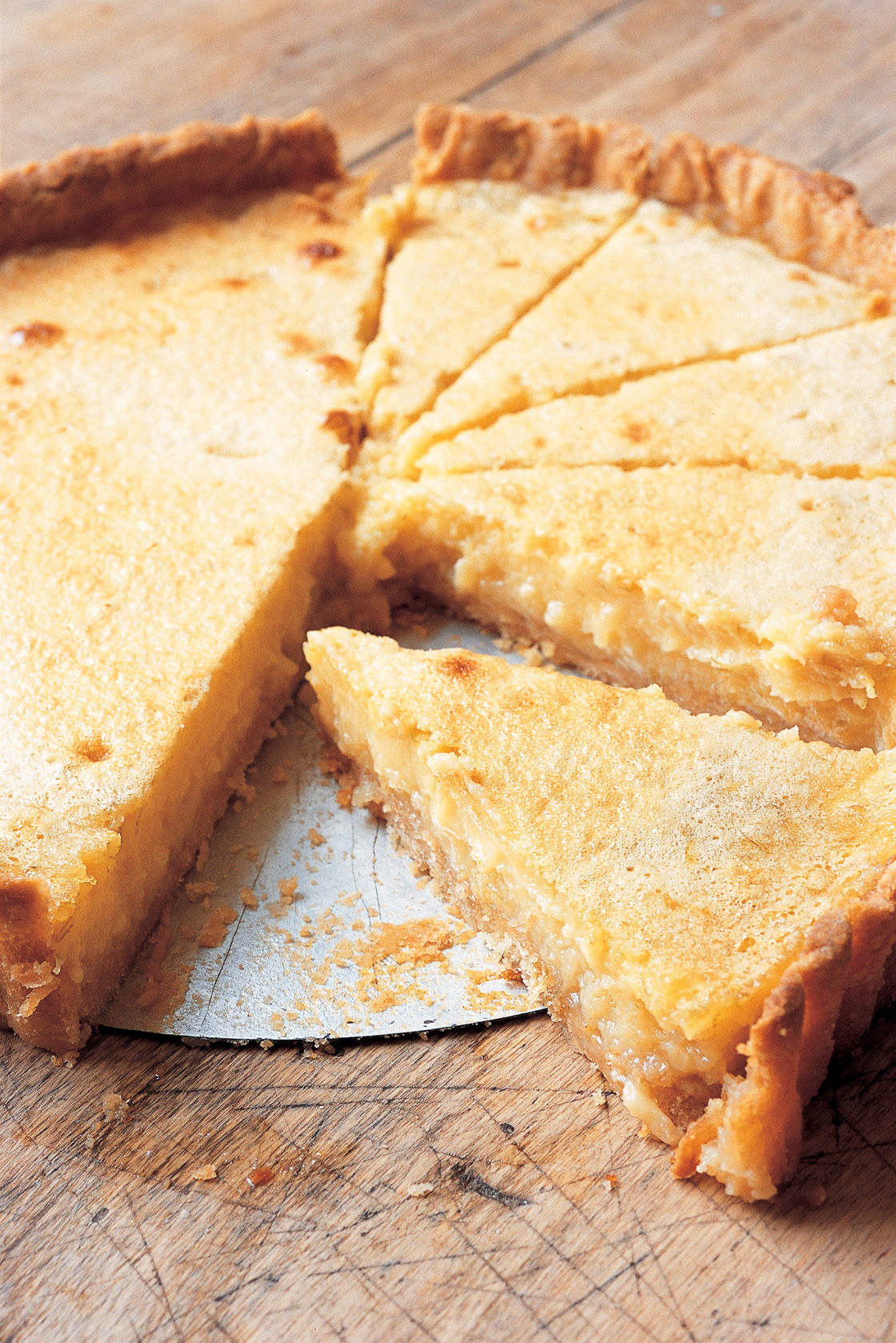
A lime tart
Not difficult this, but do make absolutely certain there are no holes or cracks in the pastry case, otherwise the filling will escape, I guarantee.
limes – 5–7
large eggs – 6
caster sugar – 250g
double cream – 175ml
For the pastry:
plain flour – 175g
golden icing sugar – 40g
cold butter – 90g
egg yolks – 2
cold water – 1 tablespoon
To make the pastry, put the flour and icing sugar into a food processor, add the butter, cut into chunks, and blitz for a few seconds. Stop when the mixture resembles fine breadcrumbs. Mix in the egg yolks and water. Tip into a mixing bowl and bring the dough together into a thick log with your hands. Wrap it in greaseproof paper and refrigerate for a good half hour. Warning: skipping this bit will make your pastry shrink.
Cut thin, round slices from the log of pastry, then press them into a loose-bottomed 23–24cm tart tin with high sides (3.5cm), pressing the pastry gently up the sides and over the base (this pastry is too fragile to roll). Make certain that there are absolutely no holes, otherwise the filling will leak through. Prick lightly with a fork and refrigerate for half an hour.
Set the oven at 200°C/Gas 6. Place a sheet of greaseproof paper in the tart case and fill it with baking beans (I use old haricot beans but you can buy ceramic or metal beans especially for the job from cookware shops). Bake the tart case for ten minutes, then remove the greaseproof paper and beans and bake for a further five minutes, until the pastry is dry to the touch.
Turn the oven down to 150°C/Gas 2. Finely grate the zest from two of the limes. Squeeze enough limes to give 180ml juice; this could be anything from five to seven limes, depending on their ripeness. Mix the eggs and sugar together, beating lightly for a few seconds – you don’t want it to be frothy – then stir in the lime juice and cream. Pour the mixture through a sieve and stir in the lime zest. Pour into the baked tart tin and bake for forty-five to fifty minutes. Remove whilst the filling is still a little wobbly and leave to cool.
Enough for 8
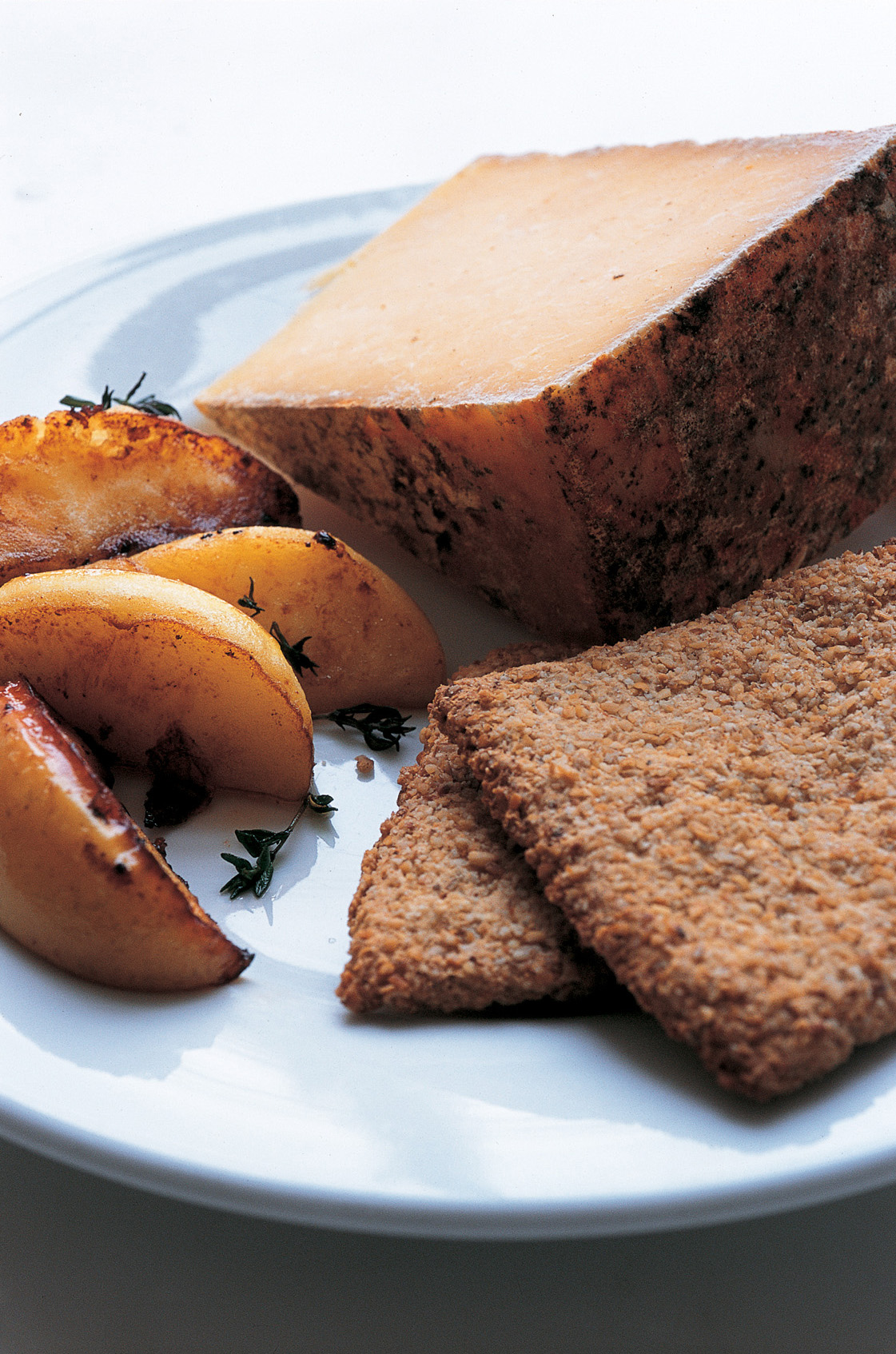
January 31
A ploughman’s lunch is something to be kept away from the whims of an imaginative cook. The most tinkering I will tolerate is the occasional oatcake in lieu of bread and the odd radish or pickled onion as a crunchy distraction. If the cheese is firm and British then I’ll willingly take an apple too. Today I slice a Cox’s apple and let it colour in a little butter in a non-stick frying pan. I put a jagged piece of Mrs Appleby’s Cheshire cheese and a slice of warm, tender apple on to each oatcake and eat them whilst the apple is still hot. Yes, a mucked-about ploughman’s but surprisingly none the worse for it.

february
Chicken patties with rosemary and pancetta
A herb and barley broth to bring you back to health
Spiced roast potatoes with yoghurt and mint
Lamb shanks with mustard and mash
Smoked haddock with flageolet beans and mustard
Roast pumpkin, spicy tomato sauce
Kipper patties, dill mayonnaise
Pork chops, mustard sauce
Linguine alla vongole
Hot chocolate puddings
Sausage and black pudding with baked parsnips
Braised lamb with leeks and haricot beans
Spiced pumpkin soup with bacon
Slow-roast lamb with chickpea mash
Braised oxtail with mustard and mash
Treacle tart
Warm soused mackerel
February 1
The thought of shopping for home-grown fruit and vegetables in February makes my heart sink. There is only so much enthusiasm you can muster for kohlrabi and potatoes, floury apples and crates of stinky old sprouts.
As I turn the corner by the farmers’ market, I am greeted by a stall almost hidden by tin buckets of daffodils, the traditional variety with large trumpets, the sort that look so cheerful in a jug by the kitchen sink. Beyond them is David Deme’s apple stall with bright boxes of Cox’s as crisp as shattered ice, russets still in fine nick and plump Comice and Conference pears. There is much pleasure to be found in a pear on a cold winter’s day, with its crisp flesh and sweet, nutty juice.
Iridescent, candy-striped beetroots I have only ever seen in a seed catalogue, boxes of curly, red and Russian kale, fat carrots for juicing and tight little Brussels on the stem are in A1 condition. One grower is showing a wooden crate of the perkiest celeriac I have ever seen, each root with a neat tuft of green leaves looking as if they were dug only an hour ago.
I stop at the stall selling cartons of Hurdlebrook Guernsey cream from Olive Farm in Somerset and proper untreated milk. Dairy produce doesn’t come better than this. It is not just about richness, it is about flavour. This is cream worth waiting all week for, a world away from the thin white stuff in the ‘super’markets. I buy double cream and then rhubarb for a fool. The shopping trip I almost abandoned as a bad idea has come good, and I walk home with a heavy basket.
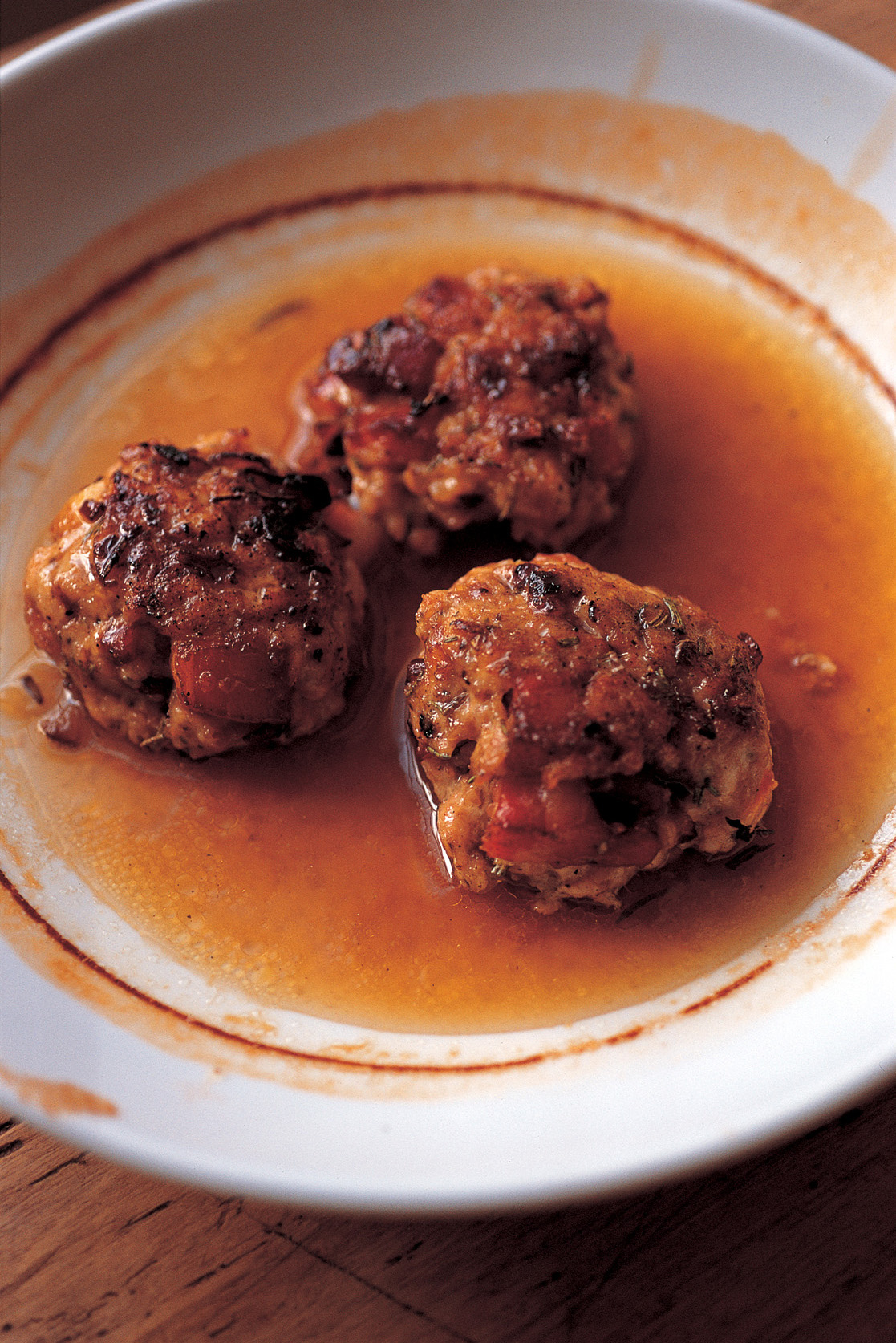
February 2
Succulent
little patties
for four
It is the deep, salty stickiness of food that intrigues me more than any other quality. The sheer savour of it. The Marmite-like goo that adheres to the skin of anything roasted; the crust where something – usually a potato or a parsnip – has stuck to the roasting tin; the underside of a piece of meat that has been left long enough in the pan to form a gooey crust. This is partly why I cook rather than buying my supper readymade. This you will probably know, unless of course this is your first Nigel Slater book.
Meatballs, left to cook without constant prodding and poking, will form a satisfyingly savoury outer coating that presses all the right buzzers for me. In many ways they are the ultimate casual supper for friends. I say this because of their ability to wait patiently when people are late, to cook quickly so you are not away from your guests for long and, the real clincher, because of the fact that they have a down-to-earth friendliness to them. A meatball never says, ‘Look at me, aren’t I clever?’ It just says, ‘Eat me.’ No matter how fancy you get in terms of seasoning and sauces, you can’t show off with them. Best of all, they are one of the few recipes you can easily multiply for a large number without having to rejig everything. You just double or quadruple as you need. This is of particular resonance today. There are four of us for supper tonight and I know two of them will almost certainly be late. They always are.
Chicken patties with rosemary and pancetta
I put these on the table with fat wedges of lemon and a spinach salad.
a medium onion
garlic – 2 cloves
a thick slice of butter
cubed pancetta – 100g
rosemary – 3 bushy sprigs
minced chicken – 450g
a little groundnut oil for frying
chicken stock – 250ml
Peel the onion and garlic and chop them finely, then let them soften in the butter over a moderate heat (a non-stick frying pan is best for this, then you can use it to fry the patties in later) until they are lightly honey-coloured. Stir in the small cubes of pancetta. Strip the rosemary leaves from their stalks, chop them finely, then add them to the onions, letting them cook for a few minutes till coloured. Let the mixture cool a little.
Mix the minced chicken into the onion, seasoning it generously with black pepper and a little salt (the pancetta will contribute to the seasoning).
Set the oven at 190°C/Gas 5. Now, to make the simple patties, shape the mixture into six little burgers about the size of a digestive biscuit, then leave to settle for half an hour.
Wipe the onion pan clean and get it hot. Add a little groundnut oil and brown the patties on both sides – that’s a matter of three minutes per side – then transfer them to an ovenproof dish. Pour in the stock and bake for twenty-five to thirty minutes, till the patties are sizzling and the stock is bubbling. Serve two to three per person and spoon over some of the hot chicken stock.
Enough for 2–3.
Note
If you want something richer, make stuffed patties. Take a heaped tablespoon of the chicken mixture and push a hollow in it with your thumb. Take a heaped teaspoon of Gorgonzola cheese (you will need 75g for this amount of chicken) and push it into the hollow, then cover it with a second tablespoon of chicken mixture. Squash gently to form a patty and place on a baking sheet. Continue with this till you have used up the mixture – you will have about six – then refrigerate them for twenty to thirty minutes before cooking.
February 4
Broth
I try planting some late crocus bulbs in the garden, which I had forgotten about and which now appear to have started sprouting. There’s a freezing wind and my fingers are numb even through the fleece-lined luxury of leather gardening gloves. Another of those days when you feel you are going to get snow but all that appears is sleet, which has neither the romance of snow nor the refreshing quality of rain. The ice-cold needles prickle your skin, your cheeks start to lose all feeling. I battle on till I think my nose might be running, but my face is so cold I am not sure. I call it a day and make a big pot of chicken broth, as much out of defiance as anything else.
A herb and barley broth to bring you back to health
The herbs are essential and I don’t suggest goose fat just to be annoying; it contains a certain magic.
pot barley – 100g
carrots – 3 large
leeks – 3, trimmed and rinsed to remove any grit
celery – 3 medium-sized stalks
onions – 2
garlic – 4 large cloves
dripping, goose fat or olive oil – a couple of tablespoons
enough good chicken stock to cover
a few bay leaves
thyme – 3 or 4 sprigs
sage leaves – 6
potatoes – 4 small to medium
parsley – a small bunch
Simmer the rinsed barley in salted water for about twenty minutes till it feels reasonably tender, then drain it. Set the oven at 180°C/Gas 4.
Peel the carrots and cut them into large chunks, then cut the leeks and celery into short lengths. I think it is important to keep the vegetables in fat, juicy pieces for this. Peel the onions, cut them in half and then into large segments. Peel and finely slice the garlic. Warm the fat in a large, deep casserole. Turn the vegetables and garlic in the hot fat and let them soften a little, but don’t allow them to colour. Bring the stock to the boil in a separate pan.
Now add the barley to the vegetables, pouring over the hot stock and tucking in all the herbs except the parsley as you go. Slice the potatoes the thickness of pound coins and lay them over the top of the vegetables – some will inevitably sink; others will sit on top, the stock just lapping at their edges.
Cover with a lid and place in the oven for an hour and a half, by which time the vegetables will be meltingly tender. Remove the lid (the smell is part of the healing process), turn the heat up to 200°C/Gas 6 and leave for thirty minutes for the potatoes to colour here and there. Remove very carefully from the oven – the pan will be full and very hot – chop the parsley and sink it into the broth.
Spoon the vegetables, barley and plenty of broth into shallow bowls with flakes of sea salt and several firm grinds of the pepper mill.
Enough for 4
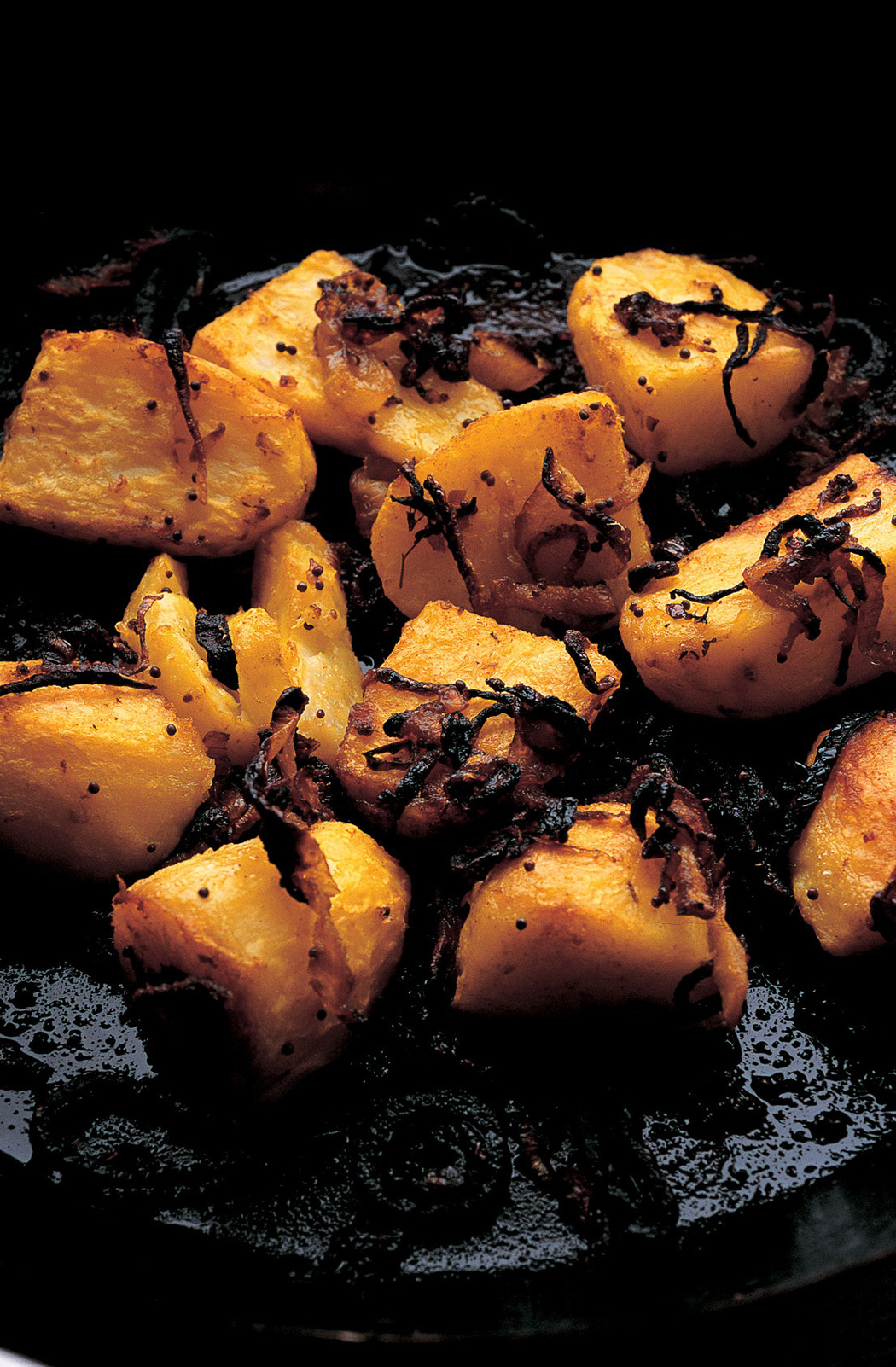
February 6
Cold meat,
hot potatoes
There is cold meat to eat up from yesterday’s roast but it needs something warming to sit alongside. So potatoes it is, spiced with onions and chillies, all cooked to a crisp. To be honest, I let it cook for longer than I intend, with the result that the onions are crisp and slightly singed. A plate of big, mouth-popping flavours that I cool by drizzling yoghurt over at the table.
Spiced roast potatoes with yoghurt and mint
When Indian cooks bake potatoes, they tend to add spices and some sort of liquid, such as water or yoghurt, but I see no reason why you cannot add the yoghurt afterwards, which has the advantage of allowing the potatoes to crisp nicely. A moderate heat is needed here to stop the spices burning in the oven.
potatoes – 4 medium
onions – 2 medium
vegetable or groundnut oil
red chillies, as hot as you like – 2, chopped
garlic – 2 cloves, crushed
cumin seeds – half a teaspoon
ground turmeric – half a teaspoon
To finish:
natural yoghurt – 4 tablespoons
a little mild ground chilli
young mint leaves – a palmful, chopped
Peel the potatoes, cut them into the sort of pieces you would for normal roasting, then bring them to the boil in deep water. Add salt to the pot and simmer for ten to fifteen minutes, until the potatoes are approaching tenderness. You should be able to slide a knifepoint through them with almost no pressure. Drain the potatoes thoroughly, then very gently shake them in their pan so the edges fluff and ‘bruise’. Set the oven at 180°C/Gas 4.
Peel the onions and slice them finely. Heat enough oil in a roasting tin to make a thin film over the bottom. The thicker the base, the less likelihood there is of the spices burning. As the oil warms, add the sliced onions and let them soften, then stir in the chopped chillies, garlic and cumin and let them warm through, stirring (and watching like a hawk) so that they do not burn. Add the potatoes to the hot oil, add the turmeric, then slowly stir and toss the potatoes so that they are covered with the seasoned oil.
Roast the potatoes in the preheated oven until they have started to crisp. Thirty to thirty-five minutes or so should do it. You don’t want them to be as brown as classic roast potatoes. They should be golden and flecked with spice.
As the potatoes come from the oven, grind over a seasoning of salt, then spoon over the yoghurt, sprinkle with a very little mild ground chilli and scatter with the chopped mint leaves.
Enough for 4 as a side dish
February 7
Lamb
shanks to
warm the
soul
A chill day, the sky the colour of wet aluminium. I need the sort of meal that ends with everyone squishing their potatoes into the meaty, oniony sauce on their plate. A sauce that is warm rather than spicy, enriched with the goodness of meat cooked on the bone.
The butcher suggests lamb shanks, cheaper now they are not so trendy. I buy nothing else; there is wine, bay, rosemary, garlic and grain mustard in the kitchen already. The preparation will take ten minutes, the cooking an hour and a half on a low heat. A supper of melting tenderness.
Lamb shanks with mustard and mash
olive oil
lamb shanks – 2 small
onions – 4 small to medium
bay leaves – 3
sprigs of rosemary – 2 or 3
vegetable or meat stock – 250ml
red wine – 250ml
garlic – 3 cloves
grain mustard – 1 heaped tablespoon
To serve:
mashed potato and a bit more mustard
Set the oven at 160°C/Gas 3. Warm a couple of tablespoons of olive oil in a roasting tin large enough to take the meat snugly, then seal the lamb on all sides in the hot oil. The fat and the cut end of the meat should take on a little colour.
Peel the onions, slice them in half from root to tip, then each half into quarters. Add them to the lamb with the bay leaves and the leaves from the rosemary sprigs. Pour in the stock and red wine. Peel the garlic cloves and squash them flat with the blade of a heavy knife. Drop them into the roasting tin with a grinding of salt and some coarse black pepper. Cover the dish with foil, place in the oven and bake for an hour and a half.
Half way through cooking, uncover the dish and stir in the mustard, turning the lamb as you do so. Cover once more and return to the oven. Serve with mashed potato and a bit more mustard.
Enough for 2
February 8
A smoked





